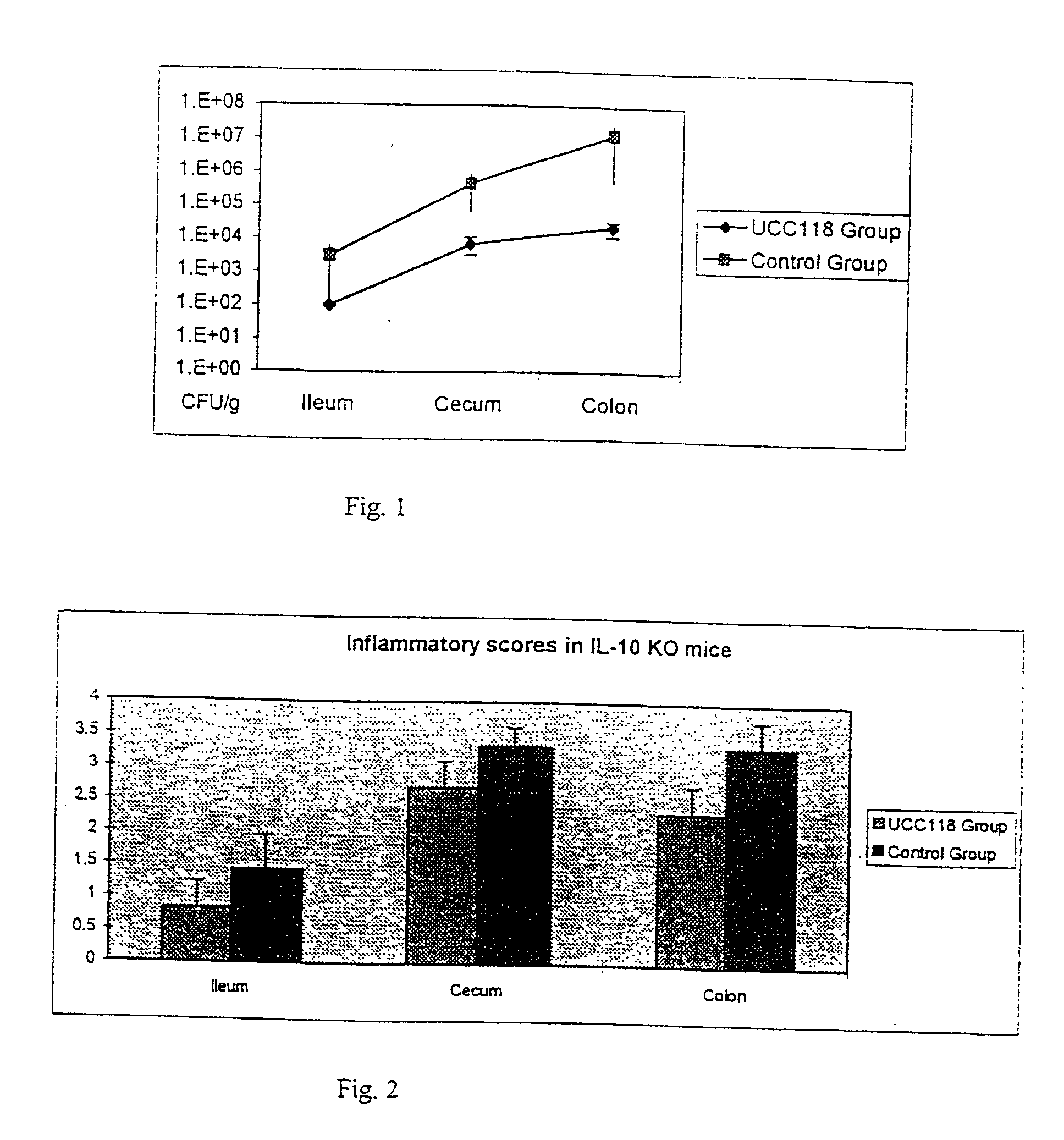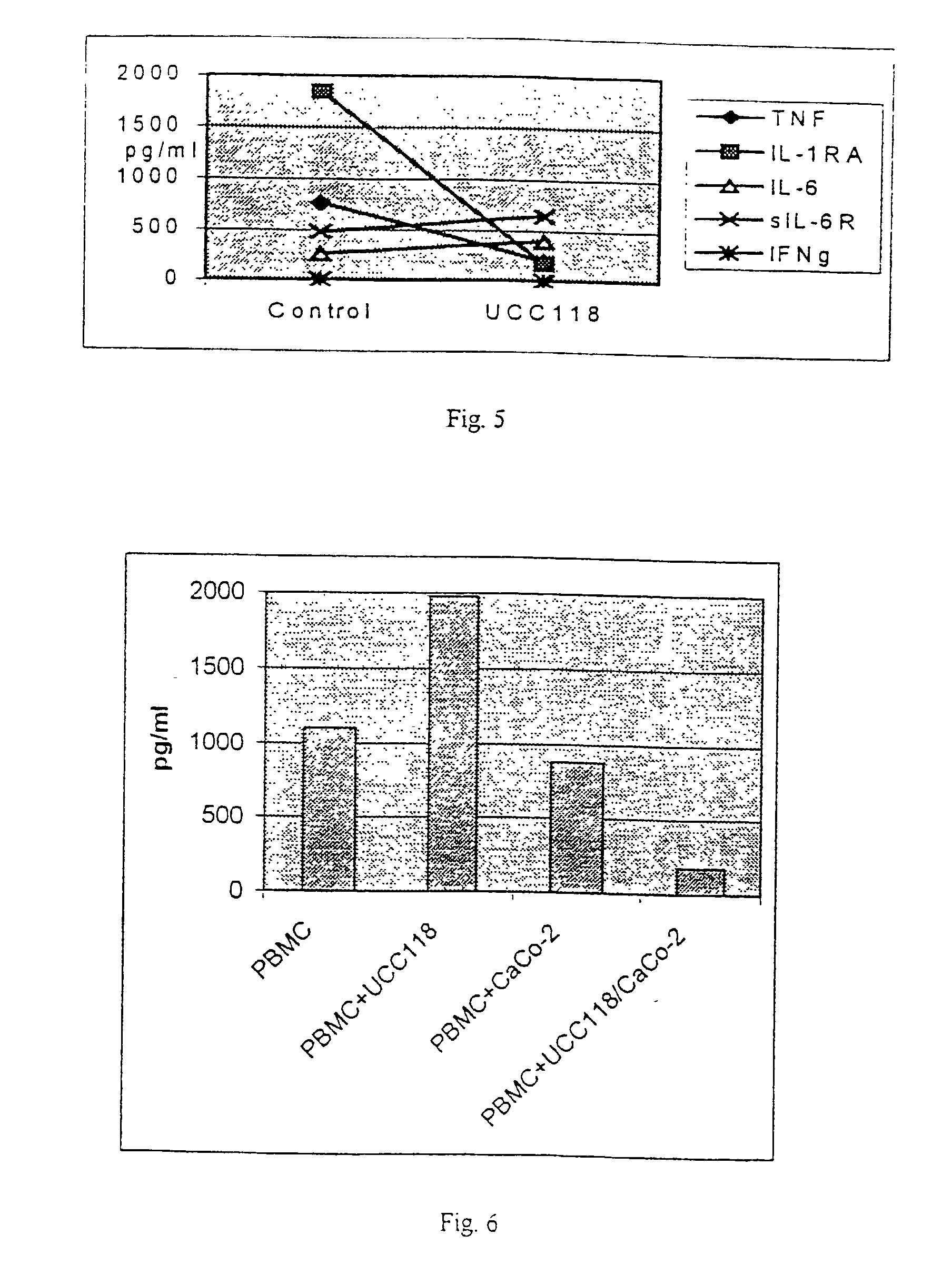Use of Lactobacillus salivarius
a technology of lactobacillus and salivarius, which is applied in the field of use of lactobacillus salivarius, can solve the problems of destroying host cells and tissue function, and achieve the effects of promoting cellular activation and pathogen destruction, and eliminating the threat of bacterial bacteria
- Summary
- Abstract
- Description
- Claims
- Application Information
AI Technical Summary
Benefits of technology
Problems solved by technology
Method used
Image
Examples
example 2
[0056] Human Trial with UCC118 in patients with active Crohn's disease.
[0057] Inflammatory bowel disease (EBD) encompasses a number of inflammatory disorders of the gastrointestinal tract, including both Crohn's disease and ulcerative colitis.
[0058] Patients suffering from active Crohn's disease have been treated with UCC118. Briefly, UCC118 was consumed in a fermented milk product for 6 weeks by 22 patients. Microbiological and immunological determinations were made at week 0, week 1, week 3 and week 6. This was not a placebo-controlled trial.
[0059] A number of systemic cytokine levels were measured over the course of feeding. In particular, tumour necrosis factor a (TNF.alpha.), a proinflammatory cytokine that has been implicated in the pathogenesis of many inflammatory disease states, including inflammatory bowel disease. Current therapies for inflammatory bowel disease specifically aim to reduce TNF.alpha. levels (Present D. H., et al. New Eng. J. Med., 1999, 340, 1398). In this...
example 3
[0061] Detailed description of the in vitro demonstration of the mechanisms underlying the anti-inflammatory effects of Lactobacillus salivarius especially subspecies salivarius UCC118.
[0062] A number of methodologies have been utilised for these studies including ELISAs (extracellular protein determination), flow cytometry (intracellular protein determination) and cDNA expression arrays (mRNA expression). In particular, examination of the expression of tumour necrosis factor .alpha. has been targeted, due to its clinical importance, and suppression of the production of this cytokine, following exposure to UCC118, has been noted using all three methodologies.
[0063] Using a transwell assay system, with epithelial cells and peripheral blood mononuclear cells, extracellular cytokine levels were measured by ELISAs. Following co-incubation with UCC118, the amount of TNF.alpha. produced was significantly reduced compared to control cultures. Furthermore, IL-1RA and IFN.gamma. levels dropp...
example 4
[0067] Test for anti-inflammatory bacterial strains
[0068] A number of lactic acid bacteria, which have been isolated from the human gastrointestinal tract, were examined in this novel assay system for anti-inflammatory effect. All bacterial strains were taken from -20.degree. C. glycerol stocks and incubated anaerobically overnight in MRS broth and washed in antibiotic containing medium. Epithelial cell monolayers were grown for 6 weeks prior to the addition of PBMCs and bacterial cells.
[0069] The results of these stimulations can be observed in FIG. 8. Relative to control cultures, two bacterial strains suppressed TNF.alpha. production. The two strains Lactobacillus salivarius strain UCC118, which suppressed production of TNF.alpha., is the subject of WO-A-9835014. The Bifidobacterium longum infantis strain UCC 35624 is the subject of a PCT Application filed concurrently with the present application.
[0070] Inflammation
[0071] Inflammation is the term used to describe the local accum...
PUM
| Property | Measurement | Unit |
|---|---|---|
| pH | aaaaa | aaaaa |
| pressure | aaaaa | aaaaa |
| acid resistance | aaaaa | aaaaa |
Abstract
Description
Claims
Application Information
 Login to View More
Login to View More - R&D
- Intellectual Property
- Life Sciences
- Materials
- Tech Scout
- Unparalleled Data Quality
- Higher Quality Content
- 60% Fewer Hallucinations
Browse by: Latest US Patents, China's latest patents, Technical Efficacy Thesaurus, Application Domain, Technology Topic, Popular Technical Reports.
© 2025 PatSnap. All rights reserved.Legal|Privacy policy|Modern Slavery Act Transparency Statement|Sitemap|About US| Contact US: help@patsnap.com



